How To Prepare The Most Delicious Thai Mango Sticky Rice
Thai Mango Sticky Rice is more than just a dessert it’s a taste of Thailand’s tropical paradise. At Just Thai Recipes, our mission is deeply rooted in sharing authentic Thai flavors with the world. As we share on our About page, the journey began in a small kitchen filled with the aromas of coconut milk, fragrant jasmine rice, and freshly sliced mangoes. It was here that a passion for preserving family recipes and culinary traditions took shape. This blog isn’t just about food—it’s about storytelling, culture, and inspiring people to create restaurant-worthy Thai dishes at home.
In this guide, we’ll take you on a flavorful journey to discover everything about Thai Mango Sticky Rice—how it originated, why it’s so beloved, and most importantly, how you can make it perfectly in your own kitchen. You’ll learn what makes this dessert special, the secret behind its rich coconut sauce, and expert tips that even Thai grandmothers swear by. If you’ve been searching for the best mango sticky rice recipe, you’re in the right place.
Looking for inspiration? Try our Thai Red Rubies Dessert for another refreshing Thai sweet treat.
Table of Contents
Table of Contents
The History and Popularity of Thai Mango Sticky Rice
Origins of Mango Sticky Rice in Thailand
Thai Mango Sticky Rice, known locally as “Khao Niew Mamuang,” is more than a seasonal dessert—it’s a cultural icon. This dish has its roots in ancient Thai culinary traditions, where sticky rice was a staple in many households. Originally a humble countryside treat, it became a national favorite when the perfect pairing of sweet, ripe mangoes with sticky rice soaked in coconut milk was discovered.
In the 19th century, coconut milk began to feature prominently in Thai desserts, and this innovation elevated mango sticky rice into the creamy delight we know today. The dessert gained international fame thanks to Thailand’s thriving tourism industry and its vibrant street food scene. Tourists strolling Bangkok’s night markets often find it impossible to resist the glistening mounds of sticky rice served alongside golden mango slices and drizzled with luscious coconut sauce.
This tropical sweet has transcended borders. Now, whether you’re searching for “Mango Sticky Rice near me” or trying to recreate it in your kitchen, its global popularity continues to grow.
Cultural Significance of Mango Sticky Rice
In Thailand, food is deeply intertwined with festivals, seasons, and family gatherings. Mango sticky rice is particularly associated with the summer months (March to June) when mangoes are in peak season. During Songkran, the Thai New Year, this dessert often appears on family tables as a symbol of sweetness for the year ahead.
It’s also a dish of generosity. Sharing Thai Mango Sticky Rice with guests is a gesture of hospitality, and its vibrant presentation reflects Thailand’s love for colorful, fragrant foods. Even today, many Thais view this dessert not only as a treat but as an emblem of their culinary heritage.
Check out our Coconut Mango Chicken Curry for another fusion dish that celebrates Thailand’s love of coconut and mango.
Print
How To Prepare The Most Delicious Thai Mango Sticky Rice
- Prep Time: 30 minutes
- Cook Time: 30 minutes
- Total Time: 1 hour
- Yield: 4 servings 1x
- Category: Dessert
- Method: Steaming
- Cuisine: Thai
- Diet: Vegetarian
Description
Coconut Sticky Rice with Mango is a classic Thai dessert featuring tender, sweet glutinous rice infused with rich coconut milk, served with fresh ripe mangoes and topped with a salted coconut sauce and crispy mung beans for texture.
Ingredients
- 1 cup white glutinous rice
- ⅔ cup coconut milk
- ½ teaspoon table salt
- ½ cup sugar
- Salted Coconut Sauce:
- ½ cup coconut milk
- ¼ teaspoon table salt
- 1 teaspoon rice flour
- 1 Tablespoon water
- Others:
- 2 Tablespoons shelled and split mung beans
- 3 sweet, ripe mangoes
Instructions
- Wash the glutinous rice thoroughly, rinsing 4–5 times until water runs mostly clear.
- Soak the rice in room temperature water for at least 4 hours or overnight. If soaking longer than 4 hours, refrigerate.
- While soaking, prepare salted coconut sauce and crispy mung beans.
- Preheat a steamer and line the rack with moist muslin or a thin white tea towel. Drain rice well and place on the cloth. Fold edges over rice.
- Steam over high heat for 20–25 minutes until fully cooked and tender.
- While rice cooks, make coconut syrup by combining coconut milk, sugar, and salt in a pot. Heat until it starts to bubble, then remove from heat and keep covered.
- When rice is done, transfer to a bowl and pour the hot coconut syrup over it. Stir gently to break lumps, cover, and let rest for 20 minutes.
- Fold rice gently from bottom to top to redistribute syrup, cover again, and let sit for another 20 minutes or until serving.
- For salted coconut sauce, whisk rice flour and water until smooth. Combine with coconut milk and salt in a pot. Cook over medium-high heat, stirring constantly, until thickened and boiling. Remove and cool.
- For crispy mung beans, rinse and soak beans in simmering water for 10 minutes (off heat), then drain and dry. Toast in a lightly greased pan over medium-high heat until golden and crunchy.
- To serve, plate sticky rice with fresh mango slices, drizzle with salted coconut sauce, and sprinkle with crispy mung beans.
Notes
- For naturally colored rice, soak in colored water as per blog instructions.
- Use only white glutinous rice for authentic texture.
- Ripe mangoes are key—choose sweet, non-fibrous varieties.
- Crispy mung beans can be made ahead and stored airtight for up to 1 month.
Nutrition
- Serving Size: 1 serving (1/4 of recipe)
- Calories: 375
- Sugar: 35g
- Sodium: 220mg
- Fat: 8g
- Saturated Fat: 7g
- Unsaturated Fat: 0.5g
- Trans Fat: 0g
- Carbohydrates: 75g
- Fiber: 2g
- Protein: 4g
- Cholesterol: 0mg
Keywords: Coconut Sticky Rice, Mango Sticky Rice, Thai Dessert, Khao Niew Mamuang
Ingredients Breakdown for Thai Mango Sticky Rice
The Essential Ingredients and Their Roles
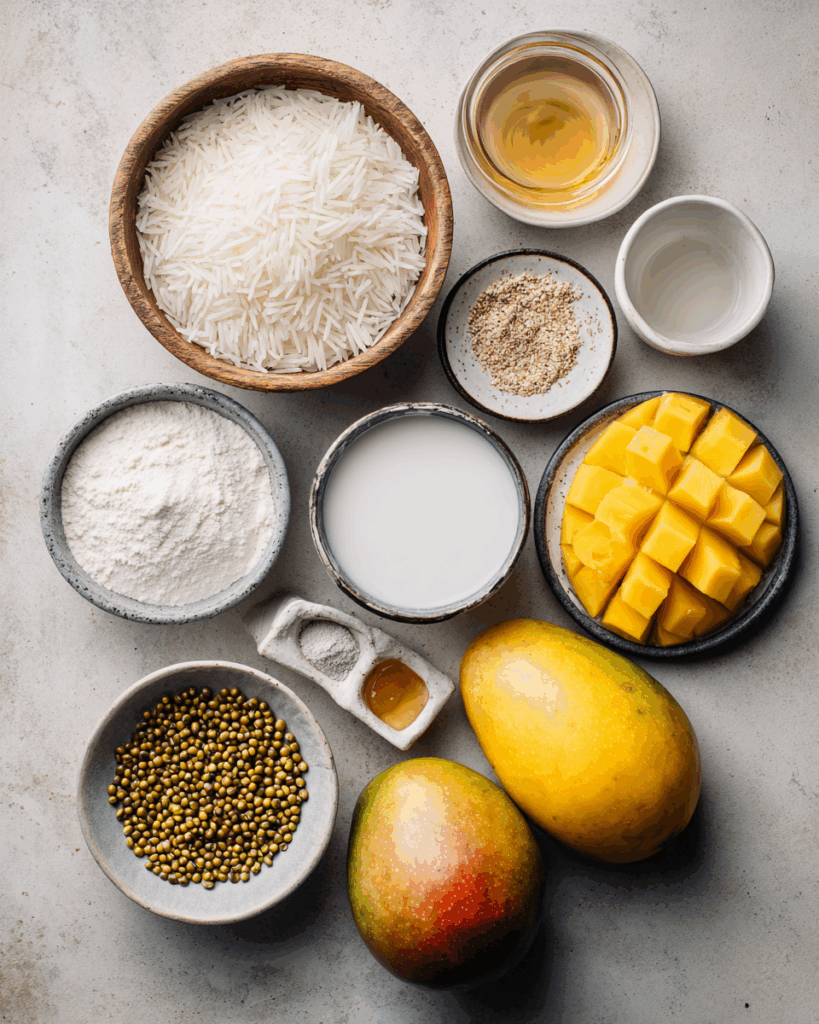
The magic of Thai Mango Sticky Rice lies in its simplicity—just a handful of ingredients combine to create a dessert that’s creamy, sweet, and unforgettable. Let’s break them down so you can understand their importance.
White Glutinous Rice (Sticky Rice)
This is the foundation of the dessert. Known as “khao niew” in Thai, glutinous rice has a unique sticky texture when steamed, making it perfect for soaking up the sweet coconut syrup. Using any other rice, like jasmine or basmati, will not yield the same chewy consistency that makes mango sticky rice so irresistible.
Coconut Milk
Coconut milk adds creamy richness and a fragrant aroma to the dish. It’s infused with sugar and salt to make a luscious syrup that coats the sticky rice. Wondering whether to use coconut cream or milk? (We’ll answer that in the next section!)
Ripe Mangoes
Sweet, juicy, and fragrant—ripe mangoes are essential. In Thailand, varieties like Nam Dok Mai and Ok Rong are prized for their intense sweetness and smooth flesh. If you can’t find these, any ripe, non-fibrous mango will do.
Sugar and Salt
A balance of sugar and salt in the coconut syrup creates that iconic sweet-savory contrast Thai desserts are famous for. The salt enhances the sweetness without overpowering it.
Shelled and Split Mung Beans
Lightly toasted mung beans provide a crunchy topping, adding a delightful texture to the soft rice and juicy mango.
This careful selection of ingredients is why this dish is consistently described as the best mango sticky rice recipe worldwide.
Coconut Milk vs Coconut Cream: What’s Best?
One of the most common questions about this dessert is: “Is mango sticky rice made with coconut cream or milk?” The answer lies in understanding the difference.
Coconut Milk
Made by simmering shredded coconut flesh in water, coconut milk has a lighter consistency and is traditionally used for both the syrup and the salted topping sauce. It delivers a balanced richness without being overwhelming.
Coconut Cream
Coconut cream is thicker, with a higher fat content. While not traditionally used in Thailand, some modern recipes swap in coconut cream for an ultra-rich and decadent result.
For authenticity, stick with coconut milk. However, if you prefer a creamier, dessert-like texture, incorporating coconut cream in the salted sauce is a delightful twist.
Looking for more coconut-inspired Thai dishes? Don’t miss our Thai Green Chicken Curry for a savory counterpart to your sweet sticky rice.
Step-by-Step Recipe for the Best Thai Mango Sticky Rice
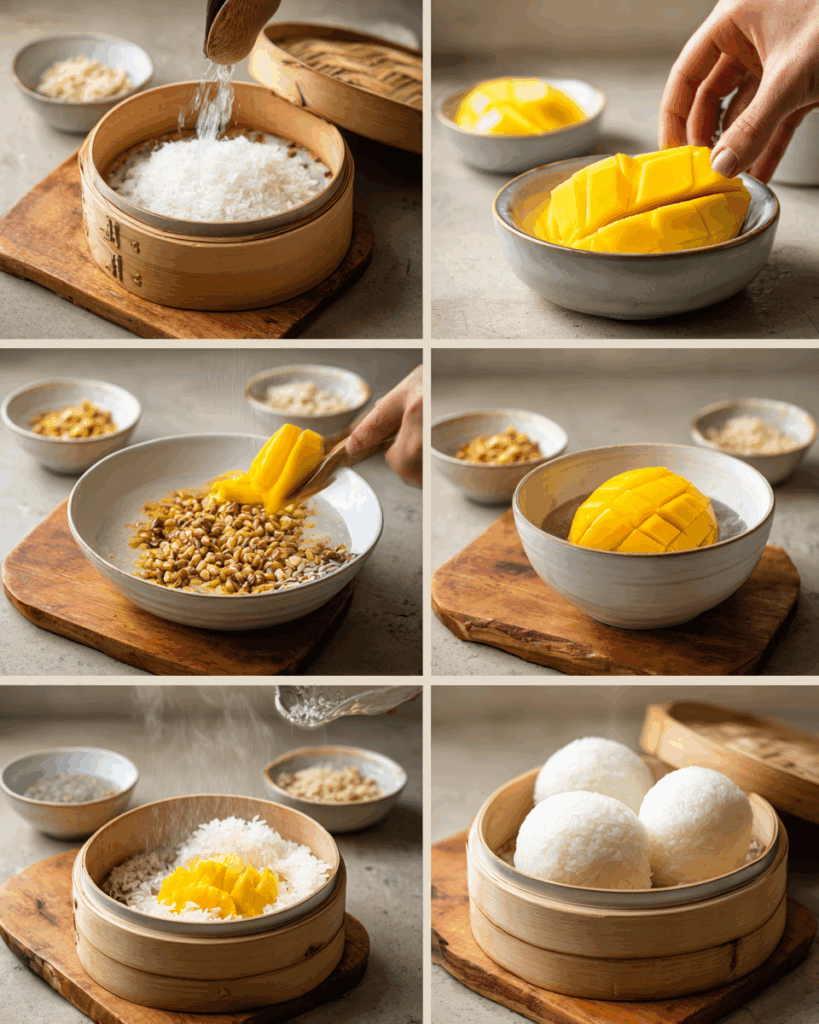
Creating the perfect Thai Mango Sticky Rice at home may sound intimidating, but it’s surprisingly simple when you follow the right steps. Let’s break it down so even beginners can achieve a restaurant-quality dessert.
Preparing the Sweet Sticky Rice Like a Pro
Ingredients for Sweet Sticky Rice
| Ingredient | Amount |
|---|---|
| White glutinous rice | 1 cup |
| Coconut milk | ⅔ cup |
| Sugar | ½ cup |
| Table salt | ½ teaspoon |
Step 1: Wash the Sticky Rice
Rinse 1 cup of white glutinous rice in a large bowl. Cover with cold water and gently swish with your hands. Drain and repeat this process four more times until the water runs almost clear. This removes excess starch and prevents the rice from becoming gummy.
Step 2: Soak the Rice
Soak the washed rice in room-temperature water for at least 4 hours or overnight for best results. If you’re planning to make colorful sticky rice, now’s the time to use naturally dyed soaking water.
Step 3: Steam the Rice
Drain the rice thoroughly. Line a steamer rack with a damp muslin cloth and spread the rice evenly. Fold over the cloth edges and cover with a tight-fitting lid. Steam over rapidly boiling water for 20–25 minutes until the rice is translucent and fully cooked.
Step 4: Make the Coconut Syrup
While the rice steams, prepare the coconut syrup. In a small pot, combine ⅔ cup coconut milk, ½ cup sugar, and ½ teaspoon salt. Heat gently until the mixture begins to bubble, then turn off the heat. If available, add a tied pandan leaf for extra fragrance.
Step 5: Combine Rice and Syrup
Once the rice is cooked, transfer it immediately into a mixing bowl. Pour the hot coconut syrup over the rice and stir gently to avoid breaking the grains. Cover with a lid or foil and let it sit for 20 minutes to allow the rice to absorb the syrup. Then, fold the rice from the bottom up to redistribute the syrup evenly and let it rest for another 20 minutes.
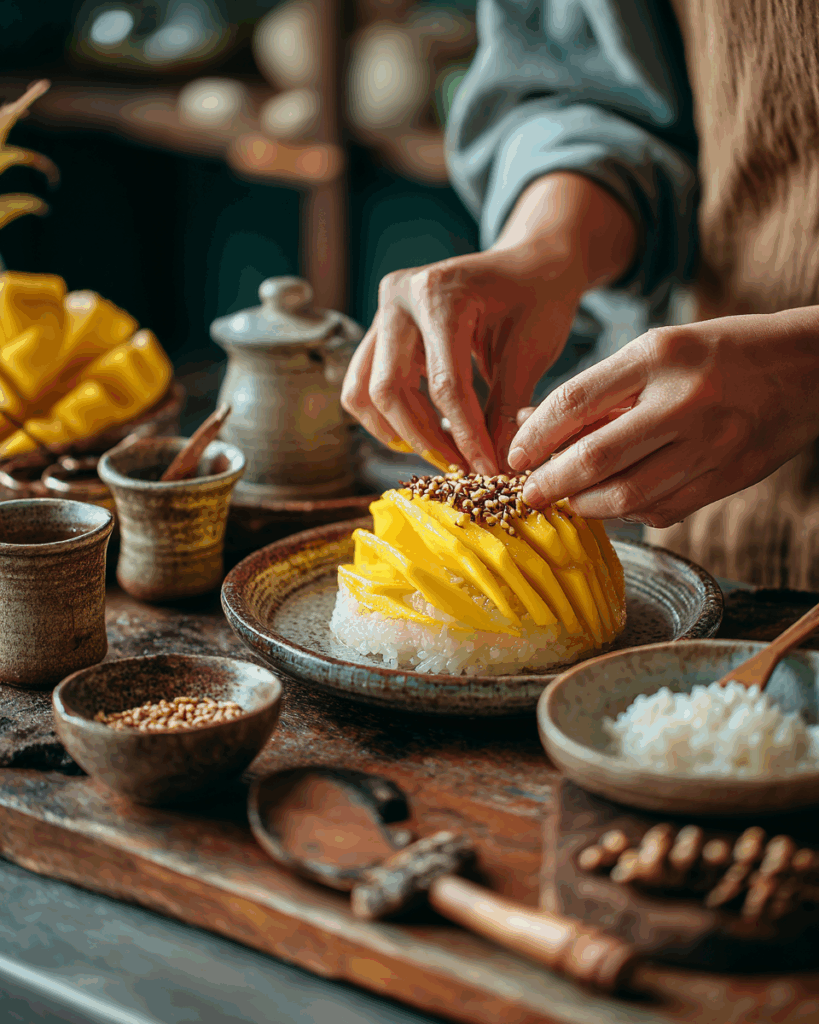
This step ensures every bite of your sticky rice is rich, sweet, and aromatic—a true hallmark of authentic Thai Mango Sticky Rice.
Making the Salted Coconut Sauce and Crispy Mung Beans
Ingredients for Salted Coconut Sauce
| Ingredient | Amount |
|---|---|
| Coconut milk | ½ cup |
| Table salt | ¼ teaspoon |
| Rice flour | 1 teaspoon |
| Water | 1 tablespoon |
Step 1: Prepare the Sauce
Mix 1 teaspoon rice flour with 1 tablespoon water to create a slurry. Combine this with ½ cup coconut milk and ¼ teaspoon salt in a saucepan. Cook over medium-high heat, stirring constantly until the sauce thickens slightly and comes to a boil. Set aside to cool.
Ingredients for Crispy Mung Beans
| Ingredient | Amount |
|---|---|
| Shelled and split mung beans | 2 tablespoons |
Step 2: Toast the Mung Beans
Rinse mung beans and cover with 2 cups of water in a small pot. Bring to a simmer, then remove from heat and cover for 10 minutes only. Drain, rinse, and dry thoroughly. Toast the beans in a lightly greased pan over medium-high heat until golden and crispy. Cool on a plate and store in an airtight container for up to a month.
Assembly: Bringing It All Together
Peel and slice 3 ripe mangoes into thin, even pieces. On a serving plate, place a generous mound of sticky rice alongside the mango slices. Drizzle with the salted coconut sauce and sprinkle with crispy mung beans for texture.
Your best mango sticky rice recipe is now ready to enjoy—sweet, salty, creamy, and crunchy in every bite.
For a savory-sweet pairing, discover great ideas like Cashew Chicken Thai Style that complement Thai desserts perfectly.
Secret Tips to Perfect Thai Mango Sticky Rice
Choosing the Perfect Mango
Not all mangoes are created equal. For truly authentic Thai Mango Sticky Rice, selecting the right variety is critical. In Thailand, Nam Dok Mai and Ok Rong mangoes are favorites because of their sweetness, low fiber, and creamy texture. Outside Thailand, look for Ataulfo (Honey) or Alphonso mangoes—they’re excellent substitutes. Avoid fibrous varieties like Tommy Atkins as their texture can distract from the silky coconut rice.
When shopping, pick mangoes that give slightly under gentle pressure and have a strong, sweet fragrance near the stem. These are signs of peak ripeness.
Cooking Hacks for Flawless Sticky Rice
Avoid Overcooking or Undercooking
Sticky rice is notorious for turning mushy or remaining hard in the center. To avoid this, always soak it long enough (4–8 hours) and steam it rather than boiling. Steaming keeps each grain intact while making them tender and sticky.
Balancing Sweetness and Saltiness
The signature flavor of Mango Sticky Rice comes from balancing sweet coconut syrup with a slightly salty drizzle. If you prefer a less sweet version, reduce sugar slightly but never skip the salt—it’s what makes the mango flavor pop.
Reheating Leftovers Without Drying Out
To revive leftover sticky rice, place it in a heatproof bowl, cover with a damp cloth, and steam for 5 minutes. This restores the soft, chewy texture without drying it out.
For additional tips, check out this highly-rated version on The Spruce Eats, which shares useful insights into perfecting the dish.
Creative Modern Twists to Impress Guests
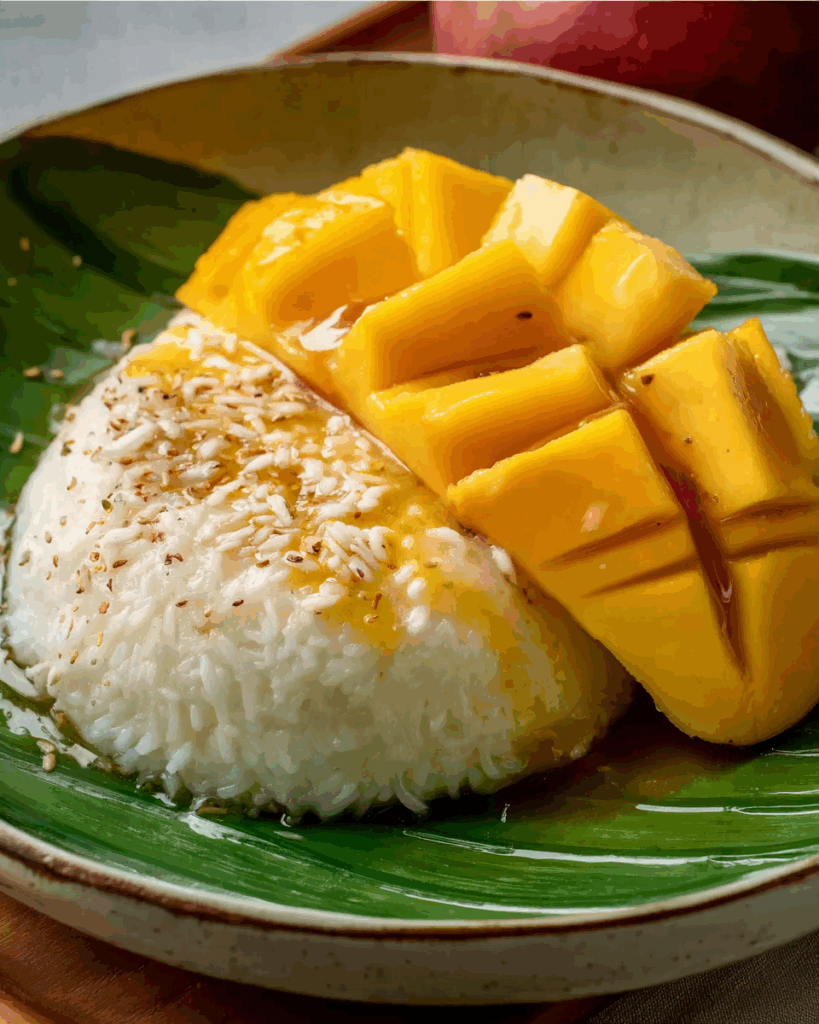
While the traditional version remains a classic, modern chefs worldwide are experimenting with innovative takes on this dessert:
- Mango Sticky Rice with Condensed Milk: Adds an extra layer of sweetness for those with a sweet tooth.
- Sticky Rice Parfaits: Layer sticky rice, mango chunks, and coconut cream in glass jars for an Instagram-worthy dessert.
- Chocolate-Drizzled Sticky Rice: A fusion twist combining Thai flavors with Western indulgence.
Want to explore unique ideas? BBC Good Food provides a beautifully simplified version you can try for a quick twist.
Common Mistakes and How to Avoid Them (Quick Table)
| Mistake | Solution |
|---|---|
| Rice too mushy | Reduce soaking time; steam instead of boiling |
| Mango underripe or sour | Choose mangoes with a sweet aroma and slight softness |
| Coconut sauce too runny | Use a rice flour slurry to thicken slightly |
| Overpowering sweetness | Adjust sugar in syrup; never skip the pinch of salt |
For a visual walkthrough, you can also visit Hot Thai Kitchen where Chef Pailin shares her traditional family recipe and video guide.
Serving and Presentation Ideas
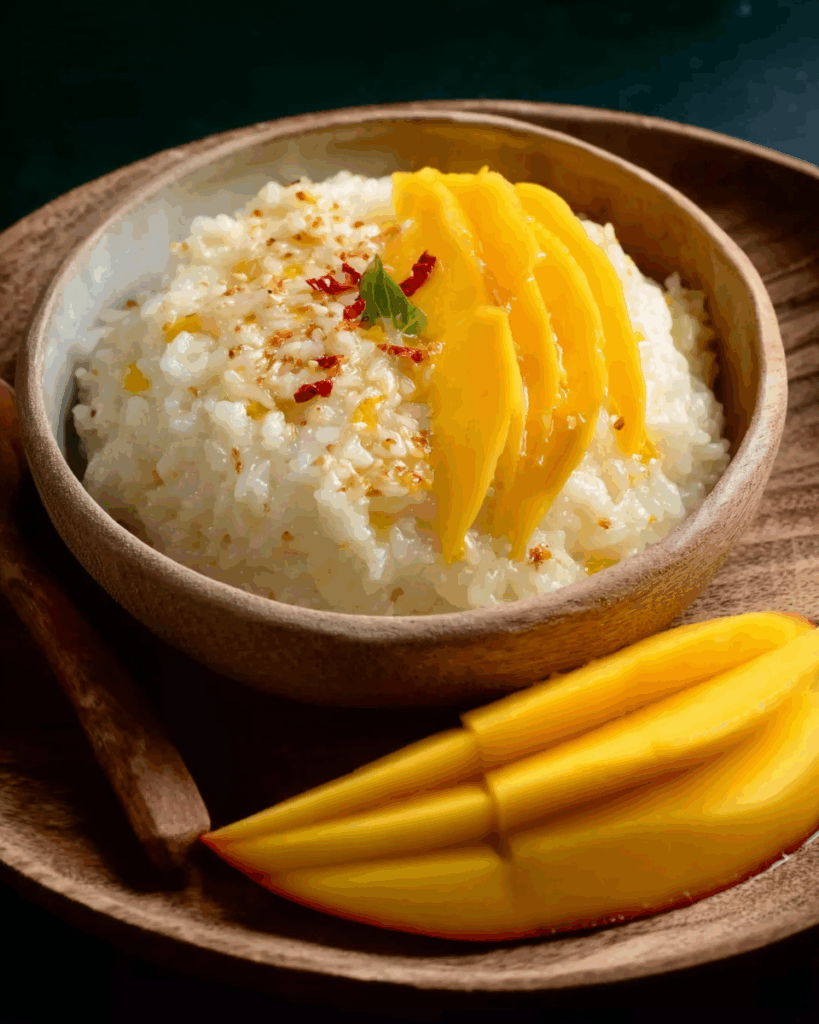
Traditional Thai Plating Styles
In Thailand, Mango Sticky Rice is as much about visual appeal as it is about flavor. The way it’s served reflects the country’s emphasis on balance, harmony, and beauty in food presentation.
Banana Leaf Platters
A classic method is to serve the sticky rice and mango slices on a banana leaf. The vibrant green of the leaf enhances the golden yellow mango and the pearly white rice, creating a feast for the eyes. A drizzle of thick salted coconut sauce over the sticky rice and a sprinkle of toasted mung beans complete this elegant look.
Individual Porcelain Bowls
Another common presentation involves small, decorative bowls. A mound of sticky rice is topped with coconut sauce, garnished with sesame seeds or mung beans, and placed alongside a fan of sliced mango. This minimalist yet elegant approach is often found in high-end Thai restaurants.
Creative Modern Twists to Impress Guests
Layered Mango Sticky Rice Parfaits
For a modern twist, layer sticky rice, mango cubes, and coconut cream in clear glass jars. This creates a visually stunning dessert that’s perfect for parties or gifts. Each layer offers contrasting colors and textures, making it both beautiful and delicious.
Deconstructed Plating
Serve the components separately on a sleek white plate: a neat dome of sticky rice, artfully arranged mango slices, a small pitcher of coconut sauce, and a side of crispy mung beans. This allows guests to assemble their bites as they please.
Colorful Sticky Rice Variations
Infuse natural colors into the sticky rice for a rainbow effect using butterfly pea flowers (blue), pandan leaves (green), or turmeric (yellow). This is popular in Thai street food markets and adds a playful element to the dessert.
Tips for Garnishes and Finishing Touches
- Sprinkle toasted sesame seeds or edible flowers for added flair.
- Use a squeeze bottle for a precise coconut sauce drizzle.
- Chill mango slices before serving for a refreshing temperature contrast.
This balance of traditional and creative styles ensures your Thai Mango Sticky Rice is a showstopper whether served at family dinners or fancy events.
Nutritional Value and Dietary Notes
Calories and Health Benefits
Thai Mango Sticky Rice isn’t just delicious—it also offers surprising nutritional benefits. While it’s undeniably a dessert and should be enjoyed in moderation, its ingredients provide essential nutrients.
Mangoes are a powerhouse of vitamins A and C, which help boost immunity, improve skin health, and provide antioxidants. Their natural sweetness also reduces the need for excessive sugar in the recipe.
Coconut milk, though rich in saturated fat, contains medium-chain triglycerides (MCTs) that can support energy levels. It also offers iron and magnesium, important for maintaining healthy blood and muscle function.
Glutinous rice contributes carbohydrates for quick energy and contains small amounts of protein.
Here’s a quick look at the estimated nutrition per serving:
| Nutrient | Amount (per serving) |
|---|---|
| Calories | 380 kcal |
| Total Fat | 10 g |
| Saturated Fat | 9 g |
| Cholesterol | 0 mg |
| Sodium | 150 mg |
| Total Carbohydrates | 70 g |
| Dietary Fiber | 2 g |
| Sugars | 25 g |
| Protein | 4 g |
| Vitamin A | 8% DV |
| Vitamin C | 35% DV |
| Calcium | 2% DV |
| Iron | 8% DV |
*DV = Daily Value based on a 2000-calorie diet.
Vegan and Gluten-Free Versions of Mango Sticky Rice
The good news is that Thai Mango Sticky Rice is naturally vegan and gluten-free, making it accessible to most dietary preferences. Here’s how:
Vegan-Friendly
Traditional recipes already avoid dairy, as coconut milk replaces cow’s milk. Just ensure no animal-based additives are used in store-bought coconut milk.
Gluten-Free Certified
Glutinous rice, despite its name, contains no gluten. It’s safe for people with gluten sensitivities or celiac disease. As always, verify that all ingredients, especially packaged coconut milk or sugar, are labeled gluten-free to avoid cross-contamination.
Portion Control and Healthier Tweaks
- Use light coconut milk to reduce saturated fat.
- Cut sugar by 25% in the syrup and rely more on mango’s natural sweetness.
- Serve smaller portions and pair with fresh fruit for added fiber.
These simple tweaks allow you to indulge guilt-free while still enjoying the authentic flavors of this tropical Thai dessert.
Common Mistakes and How to Avoid Them
Overcooking or Undercooking the Sticky Rice
The most common mistake when making mango sticky rice is mismanaging the rice texture. Sticky rice must be soft and chewy—not mushy or grainy.
Problem: The rice turns out soggy.
Solution: Always steam the rice instead of boiling it. Boiling floods the grains and washes away their natural stickiness. Ensure the rice is drained well after soaking before steaming.
Problem: The rice is still hard in the center after steaming.
Solution: Extend the steaming time in 5-minute increments and check the texture frequently. Also, ensure the rice was soaked for at least 4 hours before cooking.
Balancing the Sweet and Salty Flavors
Mango sticky rice’s charm comes from its sweet coconut syrup and the contrasting salty drizzle. However, many home cooks either over-sweeten the syrup or under-season the sauce.
Problem: Coconut syrup is overly sweet.
Solution: Taste the syrup as you cook and adjust sugar gradually. Remember, the mango’s sweetness will complement the dish, so aim for a balanced syrup rather than a sugary one.
Problem: Salted coconut sauce tastes too bland.
Solution: Don’t hesitate to add a little more salt than expected. That subtle saltiness enhances both the sticky rice and mango flavors beautifully.
Mango Selection Mistakes
Even perfectly cooked sticky rice can be let down by the wrong mango.
Problem: Mangoes are sour or underripe.
Solution: Choose ripe mangoes with a fragrant aroma and slight softness when gently pressed. Avoid greenish skin tones unless using varieties that remain green when ripe.
Problem: Mangoes are overly fibrous.
Solution: Opt for mango varieties known for smooth, creamy flesh like Ataulfo or Alphonso. Avoid fibrous types that can disrupt the dessert’s delicate texture.
Coconut Sauce Consistency Issues
The salted coconut sauce should be creamy and slightly thick to coat the sticky rice properly.
Problem: Sauce is too runny.
Solution: Add a teaspoon of rice flour mixed with water to create a slurry and stir it into the sauce over heat until it thickens.
Problem: Sauce curdles during heating.
Solution: Keep the heat at medium and stir constantly. Avoid letting the sauce boil vigorously.
Quick Reference Table: Mistakes vs Fixes
| Mistake | Fix |
|---|---|
| Soggy sticky rice | Drain thoroughly; steam instead of boiling |
| Hard sticky rice | Soak longer; steam in 5-min increments until tender |
| Overly sweet syrup | Reduce sugar; rely more on mango’s natural sweetness |
| Bland salted sauce | Increase salt slightly for balance |
| Sour or fibrous mangoes | Select ripe, fragrant, smooth-fleshed varieties |
| Runny coconut sauce | Thicken with rice flour slurry over gentle heat |
| Curdled coconut sauce | Stir constantly; avoid high heat |
Where to Find Mango Sticky Rice Worldwide
Countries That Celebrate Mango Sticky Rice
While Thailand is undoubtedly the birthplace of Mango Sticky Rice, this tropical dessert has won hearts all over the globe. Across Southeast Asia, variations of this dish can be found in neighboring countries like Laos, Cambodia, and Vietnam. Each culture brings its unique twist to the classic recipe, yet the essence remains the same: sticky rice paired with sweet mango and creamy coconut sauce.
In Laos, for example, sticky rice itself is a daily staple. Here, coconut-infused sticky rice desserts are common, though mango may be replaced by other seasonal fruits. In Cambodia, street vendors often serve sticky rice with coconut milk and fresh fruits, creating a similar yet distinct experience.
Even outside Asia, Thai restaurants in Europe, North America, and Australia have made Mango Sticky Rice a menu favorite. For many diners worldwide, this dessert represents their first encounter with Thai cuisine’s delicate balance of flavors.
Mango Sticky Rice Near You: Global Appeal
Today, Mango Sticky Rice isn’t limited to tropical climates. From high-end restaurants in New York City to cozy dessert shops in Paris and food trucks in Sydney, it’s everywhere. This global appeal reflects the dessert’s adaptability and universal charm.
Chefs around the world have experimented with the presentation and flavors, introducing creative elements like caramelized mango slices, coconut cream infused with vanilla, or even pairing the sticky rice with exotic fruits like passionfruit and lychee. Yet, no matter where it’s served, the soul of the dessert remains tied to its Thai roots: simplicity, balance, and freshness.
Why Mango Sticky Rice Has Become a Global Trend
The popularity of Thai Mango Sticky Rice in recent years is far from a culinary coincidence. This iconic Thai dessert has captured hearts and taste buds worldwide, and its rise to fame is fueled by several key factors that go well beyond mere trendiness.
Travel Influences: Tourists visiting Thailand are often introduced to Thai Mango Sticky Rice in its authentic form—fresh, fragrant, and beautifully balanced. The combination of ripe mango, tender sticky rice, and creamy coconut sauce leaves such an impression that once travelers return home, they begin searching for restaurants or recipes to recreate Thai Mango Sticky Rice. This has led to growing demand for Thai Mango Sticky Rice across continents, making it a favorite in Asian fusion restaurants and dessert bars globally.
Vegan and Gluten-Free Appeal: One of the reasons Thai Mango Sticky Rice has become so beloved is its natural inclusivity. Being plant-based and gluten-free, Thai Mango Sticky Rice appeals to health-conscious eaters, vegans, and those with dietary restrictions. This makes Thai Mango Sticky Rice not only a cultural delicacy but also a modern dessert trend embraced in wellness-focused cafes and high-end eateries alike.
Social Media Exposure: The beauty of Thai Mango Sticky Rice cannot be overstated. Its vibrant golden mango slices, glossy coconut cream, and perfectly molded sticky rice make it a photogenic masterpiece. Food bloggers, chefs, and home cooks post stunning images and videos of Thai Mango Sticky Rice on Instagram, Pinterest, and TikTok, inspiring millions to discover or recreate this timeless Thai dessert. With every viral post, the allure of Thai Mango Sticky Rice grows stronger.
This growing international fanbase ensures that Thai Mango Sticky Rice continues to appear on menus far beyond Thailand. From Michelin-starred establishments in London to trendy food trucks in Los Angeles and dessert cafes in Tokyo, Thai Mango Sticky Rice has proven its versatility and universal appeal. Even creative twists like pairing Thai Mango Sticky Rice with passionfruit, lychee, or coconut ice cream have emerged while still paying homage to its traditional roots.
Today, Thai Mango Sticky Rice is no longer just a seasonal summer treat in Thailand—it has evolved into a year-round favorite worldwide. Whether served in traditional banana leaf packages or deconstructed in elegant parfait glasses, Thai Mango Sticky Rice continues to embody the perfect harmony of sweet, salty, creamy, and fruity flavors. No matter how it’s presented, the essence of Thai Mango Sticky Rice remains a shining example of Thai culinary tradition adapted beautifully for the global stage.
Conclusion
Thai Mango Sticky Rice is more than just a dessert—it’s a true celebration of tropical flavors, cultural heritage, and culinary tradition. From its humble beginnings in Thai households to its worldwide popularity, Thai Mango Sticky Rice has captured hearts and taste buds with its stunning simplicity and irresistible taste.
By mastering the steps in this guide, from selecting the juiciest mangoes to steaming perfect sticky rice, you can bring the essence of Thai Mango Sticky Rice into your own kitchen. The beauty of Thai Mango Sticky Rice lies in its balance of sweet, salty, creamy, and fruity notes, making it an unforgettable dessert experience.
Whether served the traditional way on a banana leaf or styled in modern parfaits, Thai Mango Sticky Rice continues to impress food lovers everywhere. Its global appeal is undeniable as chefs in top restaurants and home cooks alike embrace the flavors of Thai Mango Sticky Rice for gatherings, celebrations, or simple weeknight desserts.
With each bite of Thai Mango Sticky Rice, you taste the richness of coconut cream, the tender chew of glutinous rice, and the bright, juicy sweetness of perfectly ripened mangoes. This harmony of flavors and textures is what makes Thai Mango Sticky Rice so iconic and loved across cultures.
So gather your ingredients—mangoes, coconut milk, and sticky rice—and let this guide help you recreate the magic of Thai Mango Sticky Rice. With careful preparation, you’ll be able to serve a dessert that brings the vibrant essence of Thailand straight to your dining table. Share the joy of Thai Mango Sticky Rice with your family and friends, and watch as it becomes a new favorite in your household.
Remember, the secret to perfect Thai Mango Sticky Rice is patience and attention to detail. From washing and soaking the rice properly to preparing the coconut sauce and slicing mangoes with care, every step matters. Once you master the art of Thai Mango Sticky Rice, you’ll find endless reasons to make it again and again.
FAQs About Thai Mango Sticky Rice
Is mango sticky rice made with coconut cream or milk?
Traditionally, Mango Sticky Rice is made using coconut milk. Coconut milk strikes a perfect balance between richness and lightness, ensuring the sticky rice is flavorful but not overly heavy. However, some modern adaptations use coconut cream for a thicker, more indulgent sauce. Coconut cream contains more fat, resulting in a richer flavor, but it can overpower the delicate balance if not used carefully. For authentic results, coconut milk is the preferred choice.
What country is known for mango sticky rice?
Thailand is the country most famously associated with Mango Sticky Rice. It is considered one of the nation’s iconic desserts, especially popular during mango season from March to June. The dish is widely available across Thailand, from bustling night markets to upscale restaurants, and has become a symbol of Thai culinary tradition worldwide. Its presence in neighboring countries like Laos and Cambodia further highlights its regional influence.
What is the sauce in mango sticky rice?
The sauce in Mango Sticky Rice consists of coconut milk gently cooked with sugar and a pinch of salt. This combination creates a creamy, slightly sweet, and slightly savory topping that complements both the sticky rice and mango. A small amount of rice flour is often added to thicken the sauce, giving it a luscious texture that coats the rice perfectly. This salted coconut sauce is key to balancing the dish’s sweetness and enhancing its overall richness.
What is special about mango sticky rice?
Mango Sticky Rice stands out because of its perfect harmony of flavors and textures. The chewy, warm sticky rice absorbs the sweet, aromatic coconut syrup, while the salted coconut sauce provides a subtle contrast that elevates the sweetness. Paired with fresh, juicy mango slices, the dessert offers a refreshing burst of tropical flavor. Its appeal lies in its simplicity, yet every bite feels luxurious and comforting. For many, it’s a taste of Thai culture and hospitality in dessert form.

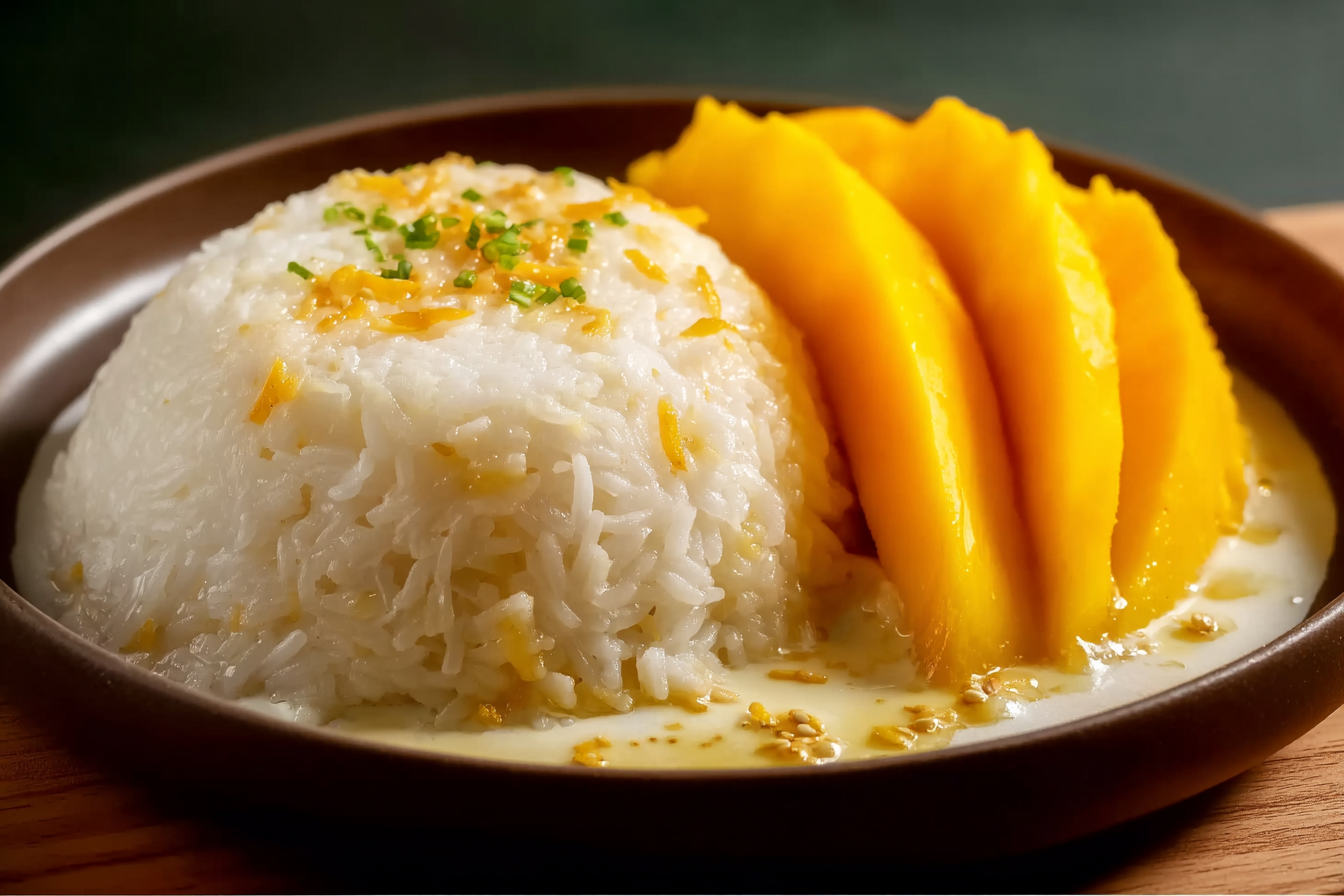
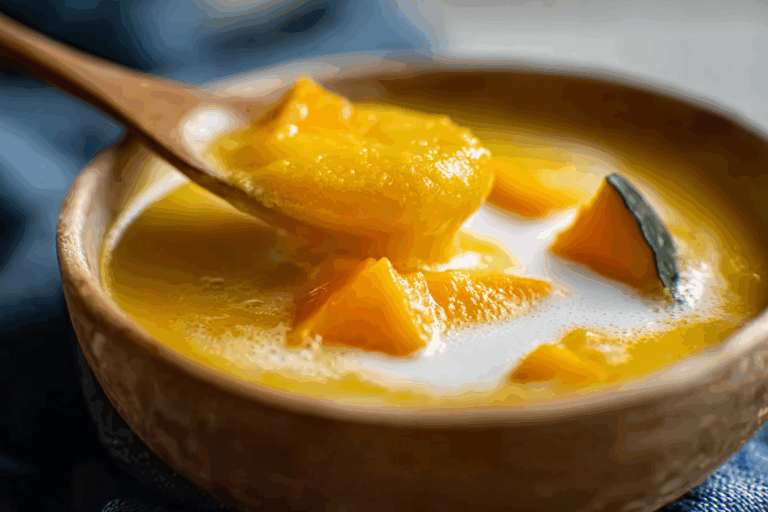
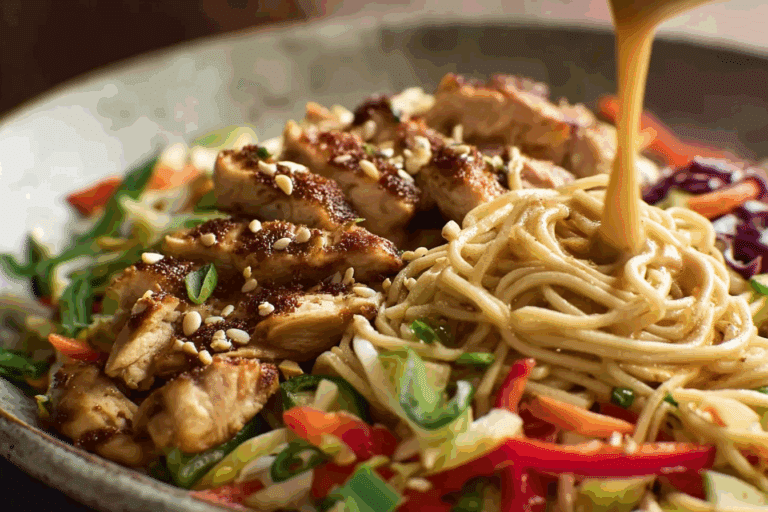
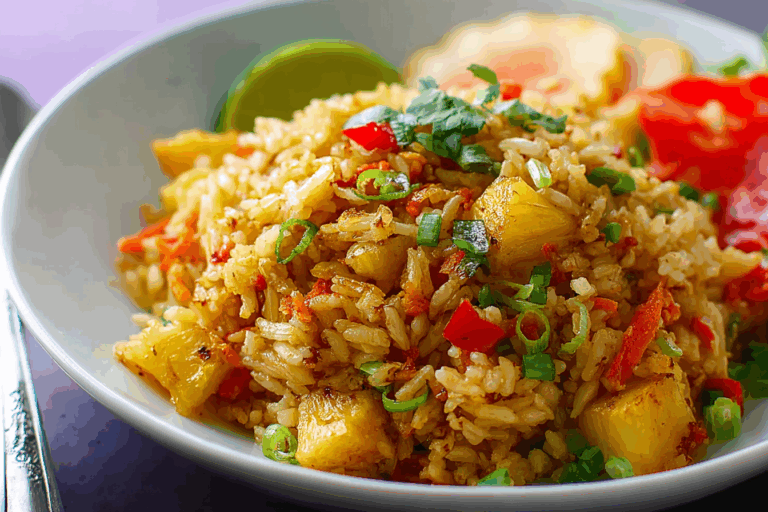
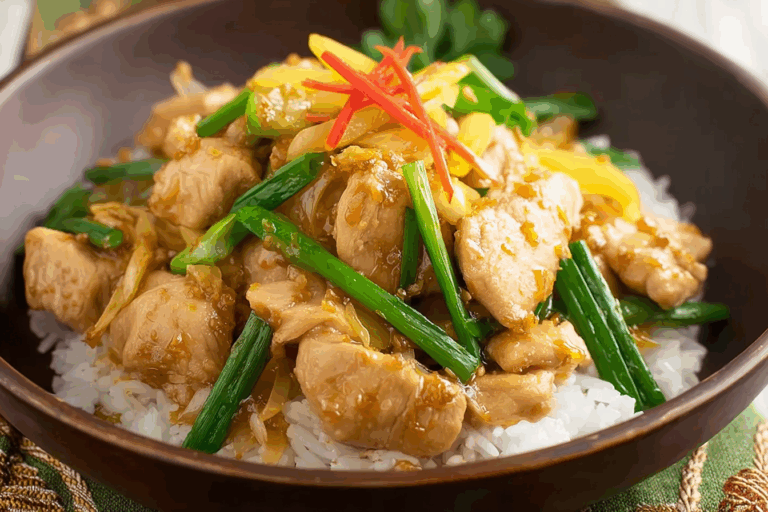
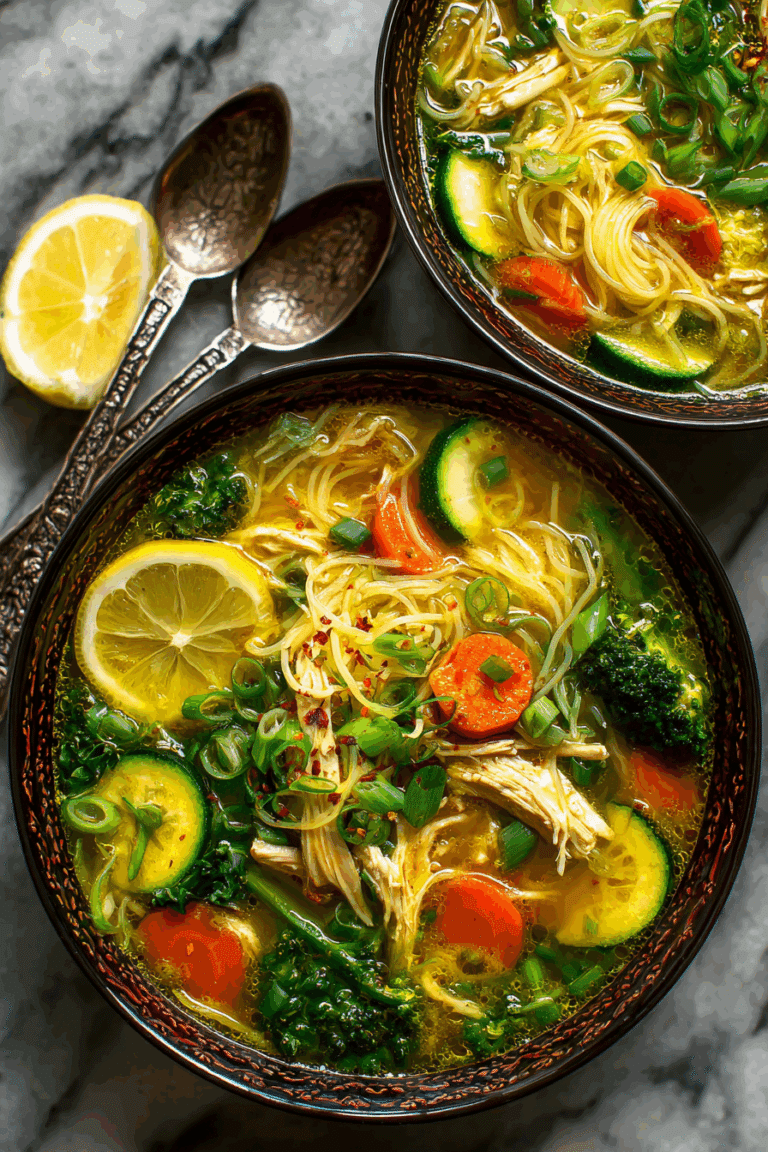
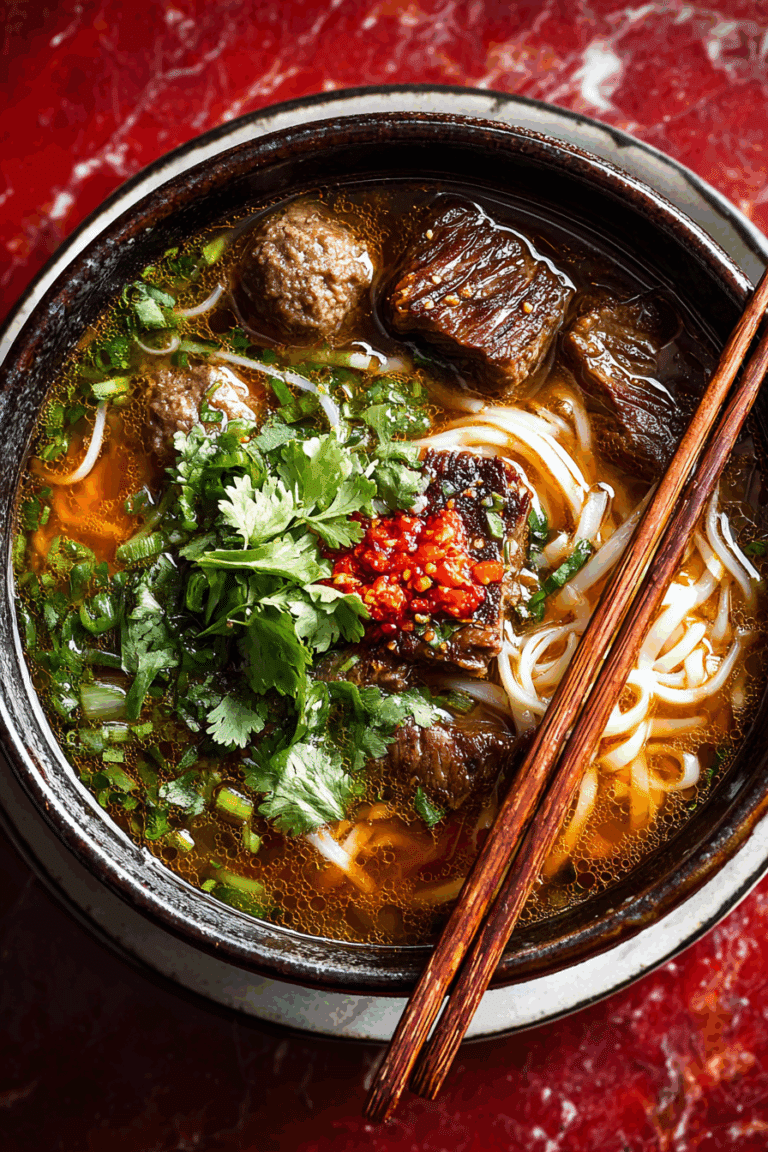
Good site! I really love how it is simple on my eyes and the data are well written. I am wondering how I could be notified when a new post has been made. I’ve subscribed to your RSS feed which must do the trick! Have a nice day!